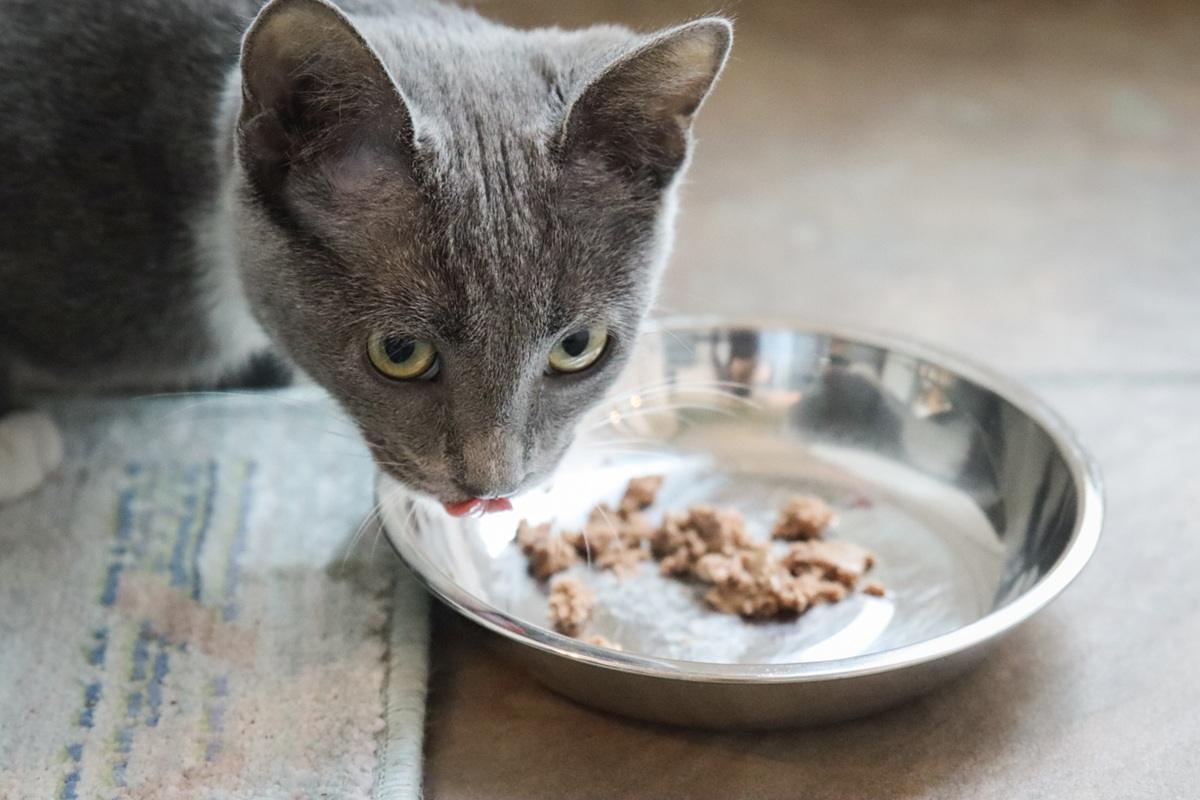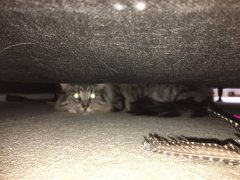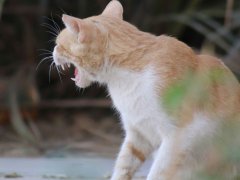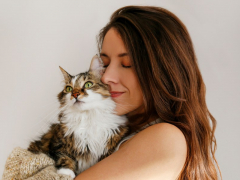
Kirsten McCarthy / Cats.com
It’s frustrating when your cat steals your other cat’s food, especially if they’re on different diets due to health reasons. It might be that your cat is hungry or that the other cat’s food tastes better, but it could also be a bullying behavior.
Cats might steal food because they are hungry or like the taste of the other food better, or as part of resource guarding or bullying behavior. Food-stealing can lead to weight gain and obesity, as well as stress and behavioral problems. You can stop cats from stealing food by feeding your cats separately or even feeding them the same food if it's approved by your veterinarian. Key Takeaways
Eating more than their fair share will likely lead to weight gain, obesity, and a host of related health issues, but it can also lead to stress and behavioral problems. Let’s look at why your cat is stealing another cat’s food and what to do about it.
Reasons Why Your Cat Might Be Stealing Your Other Cat’s Food
1. Resource Guarding and Bullying
Domestic cats are inherently solitary animals, generally preferring to live alone, in a well-defined territory. Although a few individuals are happy in closely bonded pairs or groups, most alliances will fail if the cats perceive there isn’t enough of a key resource—like food—to go around. This is an instinct that allowed them to survive as solitary hunters.
Conflict between cats living together is often subtle and easily missed by their human family, or it is dismissed as playing. One sign of feline aggression you might spot, though, is a cat stealing another cat’s food.
If all is not fine in the feline household, one cat will often block the other cat’s access to important resources like food. You might see them angle their body across both bowls, keeping them both to themselves, or they might gobble up both bowls while the other cat watches.
It might look like they’re letting them eat their food but it’s important to realize that they probably resent it, even if they don’t seem bothered to you. Cat behaviors are complex and it’s easy to miss some of the more subtle signs of stress.
2. It Tastes Better

If cats eat from different bowls or in different areas, they might decide the other cat’s is better than theirs. Kirsten McCarthy / Cats.com
If your cats are on different diets due to medical reasons or because they’re different ages, it’s possible your other cat’s food is more interesting or palatable. Kitten food is higher in protein than adult cat food, and this makes their food tastier. If your adult cat is stealing your kitten’s food then this could be why.
Cats with obesity, diabetes, hyperthyroidism, kidney disease, irritable bowel disease (IBD), and other medical conditions might be on diets that are specially tailored to their nutritional requirements.
However, these diets might be lower in protein (like kidney diets) or fats (like diets for obesity), making them less palatable than your other cat’s food. This can be frustrating as these diets can be expensive, and in most cases, they need to be fed exclusively to work. Your cat might be doing themself harm by stealing food from your other cat.
On the other hand, it might be that your other cat has a medical issue—some foods are designed to be ultra-palatable, especially those for cats with gut issues, recovery diets, or diets for senior cats.
In this case, the cat on a typical diet might be trying to steal food from the cat with a medical condition. Though this is less likely to cause problems than the other way around, it’s still expensive—and it might mean your other cat isn’t getting the nutrition they need.
3. They Prefer the Bowl or Area
Cats can become creatures of habit and routine and feel most secure if nothing changes. They also form preferences at a young age and might struggle to move from these. If your cats use different bowls or you feed them in different places in the house, it might be that your cat prefers the bowl or area that the other cat is using.
4. They’re Still Hungry
It could be that your cat is still hungry, especially if you have them on a diet. Even if they haven’t finished their food, they might grab a bite of your other cat’s food, especially if the bowl looks fuller, or even use bullying tactics (discussed above) to keep both bowls.
Even if your cat isn’t on a diet, hunger could be the reason they’re stealing food from your other cat. Diseases such as hyperthyroidism and diabetes make cats feel hungrier, and they’ll be more likely to steal food.
Similarly, diseases of the stomach or gut (like some types of diarrhea and IBD) or a heavy load of parasites can mean they aren’t absorbing nutrients, making them feel hungry even though they’re eating plenty.
Though most of these conditions come with other symptoms (like vomiting, diarrhea, incessant meowing, or thirst), you can’t rule them out without a vet visit, so you should keep these in mind if your cat has recently seemed extra hungry.
Ways To Stop Your Cat From Stealing Your Other Cat’s Food

Depending on your cats’ situation and needs, can try several different strategies to stop food-stealing. Kirsten McCarthy / Cats.com
Hopefully, from reading the list of causes of cats stealing one another’s food above, you’ve got a pretty good idea which is the case with your cats. In some cases, it’s not too big of an issue if your cat eats your other cat’s food, as long as there’s plenty to go around.
In other cases, it could cause them to become ill. There are a few things you can try in order to stop your cat from eating other cat food, and they won’t all be relevant to every situation.
1. Create Separate Feeding Areas
It’s important to create separate feeding areas in order to reduce stress in a multi-cat household. Ideally, the feeding areas should be separate enough that one cat can’t block access to both—don’t use two areas of the kitchen if your cat can sit by the door and prevent the other cat from eating. This goes for water too!
In some cases, you can shut your cats into different rooms or even separate the feeding areas using microchip cat flaps. I once saw a case where each cat’s bowl was in a cupboard, with a microchip cat flap in the door.
This sounds extreme, but it might be necessary if it’s essential that your cats don’t eat the same food—for instance, if an obese cat and a skinny cat are living together—especially if you need one of the cats to be able to free-feed.
2. Swap Bowls
If it’s possible your cat has simply taken a liking to the bowl or set-up your other cat has, try swapping and see if this resolves the problem.
3. Use Microchip Feeders

Certain automatic feeders use technology to open a lid only for the cat wearing the proper tag. Kate Barrington / Cats.com
Some feeders can be programmed only to open when the right microchip is nearby. This is a good option to prevent your cats from stealing each other’s food, but they can be expensive. You still need to separate them to prevent one cat from guarding both bowls—something they might do even if they can’t access the food inside!
4. Consider Feeding the Same Food
Why are your cats on different diets? If it’s not down to a medical condition, could they be on the same food and still have their nutritional needs met? For instance, kittens can often move to adult cat food after neutering, even if they’re only 6 months old.
And there’s no harm in feeding cat food for older cats to your healthy adult cat, as long as it’s not high-calorie prescription senior cat food. In some cases, feeding your cat a prescription diet won’t do them any harm even if they haven’t got the condition, although it might cost a bit more.
If you aren’t sure, talk to your veterinarian about whether your cats can be fed the same cat food to make life easier for you!
5. Switch up Your Cat’s Food
If you can’t give the same diet, it’s worth seeing whether you can find something that suits your cat that’s a bit tastier. For instance, if your cat has kidney disease and seems to prefer their companion’s food, see whether there’s a renal diet that’s similar in flavor or texture.
6. Get a Vet Check
If your cat has an increased appetite, it’s definitely worth scheduling a visit with your veterinarian. While there are several diseases that can cause a cat to become extra hungry, it’s usually simple to differentiate between them and rule out medical conditions as a cause of your cat’s hunger.
Final Thoughts

Address food-stealing behavior so your cats are getting the right nutrition and can live harmoniously together. Kirsten McCarthy / Cats.com
Cats often steal one another’s food for behavioral reasons, but there are some medical causes for greediness, too. If your cat is stealing your other cat’s food, it’s best to separate them at mealtimes until you can find a solution, which might involve taking them for a vet check to make sure there’s nothing going on.
Most importantly, it’s best to tackle this behavior right away, as stealing food can lead to stress and obesity, both of which can cause health issues.
Frequently Asked Questions
Why does my cat push my other cat away from the food bowl?
It’s likely your cat is guarding a precious resource—food—in order to keep it for themselves. This is a natural behavior in solitary species like cats and should not be punished. Instead, it’s better to reorganize your cats’ eating areas to allow both cats to eat without clashing.
Is there a pecking order with cats?
Cats aren’t generally social animals, so they don’t have a "pecking order" as such (they don’t have a set way of communicating who is where in a social situation). However, cats that are more aggressive or assertive are likely to take charge, leaving those that are naturally more fearful to avoid them, which can look a bit like a pecking order.
How do you feed two cats separately?
There are lots of ways to feed two cats separately. You can give them different bowls in different rooms, use microchip feeders, or give them separate areas of the house at mealtimes. Play around to see what works for you.
Can cats share food bowls?
It’s best not to allow cats to share food bowls as it’s likely to lead to conflict. Try to give cats separate feeding areas so they aren’t too close to one another.







